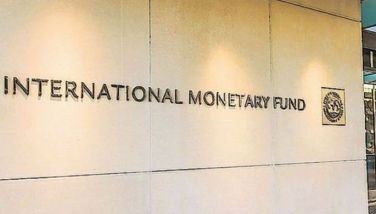Economic growth seen to hit lower end of target this year
December 21, 2006 | 12:00am
The domestic economy may not be able to hit its expected maximum growth potential for the year as the below average third quarter performance would likely pull growth at the tail end of the projected growth range of 5.5 percent to 6.1 percent.
Dennis Arroyo, director for planning and policy at the National Economic and Development Authority (NEDA), said the Philippines will likely post a full year growth of 5.5 percent this year. For 2007, he said the economy will grow slightly faster at 5.7 percent, driven mainly by continued export growth and private consumption.
In NEDA’s yearend briefing yesterday, Arroyo said the country has everything it needs to achieve its fourth quarter target of 5.7 percent. "We are confident of hitting 5.7- percent growth in the fourth quarter thus keeping us on track to meet our full-year target of 5.5 percent," he said.
"In the fourth quarter, the drivers are seasonal factors (like) Christmas spending, OFW (overseas Filipino worker) remittances and the harvest season," Arroyo noted.
He said another positive development is the subsiding world oil prices as well as the passage of the P46 billion supplemental budget which is expected to make up for the lack of spending in the past quarter.
Other factors that will ensure economic growth are the 4.7-percent inflation rate the lowest in two years; investor confidence at a five-year high; the peso hitting nearly a six-year high early this week; and a robust stock market which is at a nine-year high. "These are the things doing well for the fourth quarter," Arroyo explained.
In spite of the good news, he said the typhoons that hit the country recently have dampened economic growth. For example, typhoon Reming, which devastated the Bicol Region last October, has pulled down the country’s gross domestic product (GDP) by 0.03 percentage point. Data from the National Disaster Coordinating Council (NDCC) estimated direct costs of Reming at P13.4 billion.
In the case of typhoon Senyang, Arroyo said they have yet to compute its effect on the GDP. Senyang caused the cancellation of the ASEAN conference in Cebu this month, although he pointed out the postponement of the international conference of regional leaders had no negative effect on economic growth. "The 5.5 percent, to be conservative, does not include revenues from the ASEAN conference… the cancellation did not affect our GDP forecast," he said.
Looking forward for the coming year, Arroyo said economic growth will be boosted by OFW dollar inflows and exports. Remittances will continue to increase as the demand for Filipino laborers are expected to remain strong in the coming years. "This is a long term phenomenon driven by demographics," he said.
Exports, on the other hand, are seen to expand by 10.5 percent in 2007 despite warnings from other economists that overseas sales will go down together with the soft landing of the American economy.
Arroyo said the country’s exports are not dependent on the American market. "Our export market is diversified." Although America remains the country’s biggest market accounting for 18 percent of exports, it is closely followed by Japan and ASEAN countries at 16.9 percent each.
"Despite the US slowdown, the sheer demand for electronics will drive our exports," he noted. Two thirds of the country’s exports are in electronics.
Dennis Arroyo, director for planning and policy at the National Economic and Development Authority (NEDA), said the Philippines will likely post a full year growth of 5.5 percent this year. For 2007, he said the economy will grow slightly faster at 5.7 percent, driven mainly by continued export growth and private consumption.
In NEDA’s yearend briefing yesterday, Arroyo said the country has everything it needs to achieve its fourth quarter target of 5.7 percent. "We are confident of hitting 5.7- percent growth in the fourth quarter thus keeping us on track to meet our full-year target of 5.5 percent," he said.
"In the fourth quarter, the drivers are seasonal factors (like) Christmas spending, OFW (overseas Filipino worker) remittances and the harvest season," Arroyo noted.
He said another positive development is the subsiding world oil prices as well as the passage of the P46 billion supplemental budget which is expected to make up for the lack of spending in the past quarter.
Other factors that will ensure economic growth are the 4.7-percent inflation rate the lowest in two years; investor confidence at a five-year high; the peso hitting nearly a six-year high early this week; and a robust stock market which is at a nine-year high. "These are the things doing well for the fourth quarter," Arroyo explained.
In spite of the good news, he said the typhoons that hit the country recently have dampened economic growth. For example, typhoon Reming, which devastated the Bicol Region last October, has pulled down the country’s gross domestic product (GDP) by 0.03 percentage point. Data from the National Disaster Coordinating Council (NDCC) estimated direct costs of Reming at P13.4 billion.
In the case of typhoon Senyang, Arroyo said they have yet to compute its effect on the GDP. Senyang caused the cancellation of the ASEAN conference in Cebu this month, although he pointed out the postponement of the international conference of regional leaders had no negative effect on economic growth. "The 5.5 percent, to be conservative, does not include revenues from the ASEAN conference… the cancellation did not affect our GDP forecast," he said.
Looking forward for the coming year, Arroyo said economic growth will be boosted by OFW dollar inflows and exports. Remittances will continue to increase as the demand for Filipino laborers are expected to remain strong in the coming years. "This is a long term phenomenon driven by demographics," he said.
Exports, on the other hand, are seen to expand by 10.5 percent in 2007 despite warnings from other economists that overseas sales will go down together with the soft landing of the American economy.
Arroyo said the country’s exports are not dependent on the American market. "Our export market is diversified." Although America remains the country’s biggest market accounting for 18 percent of exports, it is closely followed by Japan and ASEAN countries at 16.9 percent each.
"Despite the US slowdown, the sheer demand for electronics will drive our exports," he noted. Two thirds of the country’s exports are in electronics.
BrandSpace Articles
<
>
- Latest
- Trending
Trending
Latest



























